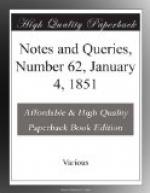ROBERT ANSTRUTHER.
Bayswater.
* * * * *
{10}
BEATRIX LADY TALBOT.
In reference to the Query of SCOTUS (Vol. ii., p 478.) respecting Beatrix Lady Talbot (so long confounded by genealogists with her more illustrious contemporary, Beatrix Countess of Arundel), perhaps I may be permitted to state, that the merit, whatever it may be, of having been the first to discover this error, belongs to myself; and that the whole of the facts and authorities to prove the non-identity of the two ladies were supplied by me to the late Sir H. Nicolas, to enable him to compile the article on the subject in the Collectanea Topographica, vol. i.; the notes to which also were almost entirely written by myself. From the note of SCOTUS, one would suppose that he had made the discovery that Lady Talbot belonged to the Portuguese family of Pinto; whereas he merely transcribes my words in p. 405. of the Addenda to vol. i. of the Collectanea.
I had originally supposed that this lady was a member of the house of Sousa, which bore a coat of four crescents, quartered with the arms of Portugal (without the border); and in that belief a paragraph was written by Sir H. Nicolas, accompanied by a pedigree, to show the connexion of Beatrix Lady Talbot, through her great-great-grandfather, with the royal line of Portugal, and, consequently, with Beatrix Countess of Arundel; but these were subsequently struck out. By an oversight, however, the note referring to some works on the genealogy of the house of Sousa has been allowed to remain at p. 87. of the Collectanea; and as it stands at present, it has no corresponding passage in the text. For the information that Lady Talbot bore the arms of Pinto, I was really indebted to a Portuguese gentleman, the Chevalier M.T. de Moraes Sarmento, who published (anonymously) a small volume entitled Russell de Albuquerque, Conto Moral, por um Portuguez, 12mo. Cintra, 1833, at p. 331-2. of which work is a brief notice of the two Beatrixes, from memoranda furnished by myself. At the time I collected the information given to Sir H. Nicolas, I wrote to the Earl of Shrewsbury, to inquire whether among the family papers any evidence could be found, to clear up the history of his ancestress; but his lordship informed me he had no means of elucidating the difficulty, and that in the earliest pedigree in his possession (drawn up in the reign of Elizabeth), Beatrix Lady Talbot was not only described as daughter of the King of Portugal, but had the royal arms of Portugal assigned to her,—a proof, by the way, that even in pedigrees compiled and attested by heralds, there are statements which are not borne out by historic documents. I am still, therefore, like SCOTUS, anxious to know more about this lady, and hope some of your correspondents versed in Portuguese genealogies may supply the required information.




